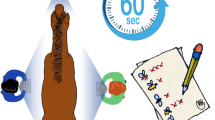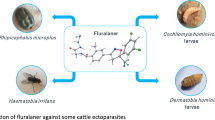Abstract
The chewing louse Werneckiella equi is an ectoparasite of donkeys and other equids. Alphacypermethrin (ACYP) is a pyrethroid insecticide commonly used for the control of insects of veterinary and public health concerns. A trial was conducted to assess the efficacy of ACYP against W. equi on naturally infested donkeys. Parasitological investigations were performed on 13 animals. On day 0, the donkeys received ACYP pour-on at the manufacturer’s recommended dose rate for cattle. Louse counts were performed on days −1, 7, 14, 21, 28, 35, 42, 49, and 56 at seven predilection sites on the skin of each donkey. ACYP was completely effective (100 %) from day 7, until the end of the study. ACYP was well tolerated by all animals as there were no observed clinical adverse reactions. ACYP was highly effective, safe, user-friendly, and considered to be suitable for the treatment of donkeys for W. equi infestation.


Similar content being viewed by others
References
Abbott WS (1925) A method of computing the effectiveness of an insecticide. J Econ Entomol 18:265–267
Al-Quraishy S, Abdel-Ghaffar F, Al-Rasheid KAS, Mehlhorn J, Mehlhorn H (2011) Observations on effects of a neem seed extract (MiteStop®) on biting lice (mallophages) and bloodsucking insects parasitizing horses. Parasitol Res. doi:10.1007/s00436-011-2495-0
Denny H (1842) Monographia anoplurorum britanniæ or an essay on the British species of parasitic insects belonging to the order Anoplura of Leach, with the modern divisions of genera according to the views of Leach, Nitzsch, and Burmeister. pp 191–192. London, (UK): Henry G Bohn. http://www.archive.org/texts/flipbook/flippy.php?id=monographiaanopl00dennrich. Acessed 12 December 2011
Eckert J, Friedhoff KT, Zahner H, Deplazes P (2008) In: Textbook of parasitology for veterinarians, 2nd edn. Stuttgart, Germany pp 200–202
Gawler R, Coles GC, Stafford KA (2005) Prevalence and distribution of the horse louse, Werneckiella equi equi, on hides collected at a horse abattoir in south-west England. Vet Rec 157:419–420
Grosenbaugh DA, Reinemeyer CR, Figueiredo MD (2011) Pharmacology and therapeutics in donkeys. Equine Vet Educ. doi:10.1111/j.2042-3292.2011.00291
Güleğen E, Çırak VY (2005) Occurrence and treatment of Bovicola (Damalinia) equi (Linnaeus, 1758) infestation on a thoroughbred horse farm. Acta Parasitol Turcica 29:183–184
Holdsworth PA, Vercruysse J, Rehbein S, Peter RJ, Letonja T, Green P (2006) Association for the Advancement of Veterinary Parasitology (WAAVP) guidelines for evaluating the efficacy of ectoparasiticides against biting lice, sucking lice and sheep keds on ruminants. Vet Parasitol 136:45–54
James PJ (1999) Do sheep regulate the size of their mallophagan louse populations? Int J Parasitol 29:869–875
Larsen KS, Eydal M, Mencke N, Sigurðsson H (2005) Infestation of Werneckiella equi on Icelandic horses, characteristics of predilection sites, and lice dermatitis. Parasitol Res 96:398–401
Linnaeus C (1758) Systema naturae per regna tria naturae: secundum classes, ordines, genera, species, cum characteribus, differentiis, synonymis, locis, 10th edn, pp 610–612. The system of nature through the kingdoms of nature: according to classes, orders, genera, and species with characteristics, differences, similarities, and places. Holmiae (Stockholm, Sweden): Laurentii Salvii. Available at: Biodiversity Heritage Library. http://www.biodiversitylibrary.org/item/10277. Acessed 12 December 2011
Littlewood J (1999) Control of ectoparasites in horses. In Pract 21:418–424
Lowden S, Gray S, Dawson K (2007) Treatment of natural infestations of the biting louse (Werneckiella equi) on horses using triflumuron, a benzoylurea-derivative insect growth regulator. Vet Parasitol 148:295–300
Lyal CHC (1985) A cladistic analysis and classification of trichodectid mammal lice (Phthiraptera: Ischnocera). Bull Br Mus Nat Hist (Ent) 51:187–346
Mencke N, Larsen KS, Eydal M, Sigurðsson H (2004) Natural infestation of the chewing lice (Werneckiella equi) on horses and treatment with imidacloprid and phoxim. Parasitol Res 94:367–370
Mencke N, Larsen KS, Eydal M, Sigurðsson H (2005) Dermatological and parasitological evaluation of infestations with chewing lice (Werneckiella equi) on horses and treatment using imidacloprid. Parasitol Res 97:7–12
Paterson S, Orrell S (1995) Treatment of biting lice (Damalinia equi) in 25 horses using 1 % selenium sulphide. Equine Vet Educ 7:304–306
Pointing S (2003) Effective louse treatment for horses. Vet Rec 153:572
Polozowski A, Czeszcyszyn T, Pytloch P (2001) Efficacy of fipronil against Werneckiella equi in horses. In: Proceedings of WAAVP, Stresa, Italy p 133
Reeves WK, Miller MM (2009) Control of Bovicola equi (Phthiraptera: Trichodectidae) with dimilin and permethrin. J Vector Ecol 6:160
Romaniuk K, Jaworski Z (2008) Effect of the breeding manner and age of primitive Polish horses on the course of Werneckiella equi invasion. Medycyna Wet 64:1034–1036
Smith VS, Palma RL (2010) Louse taxonomy, anatomy and identification workshop. Forth-International Congress on Phthiraptera (ICP4), Urgup, Cappadocia, Turkey
Sorrell MS, Fish RE, Taylor KH (2010) Pediculosis in two research ponies (Equus caballi). J Am Assoc Lab Animal Sci 49:487–497
The Donkey Sanctuary (2003) Donkey Body Condition Score Chart UK. http://drupal.thedonkeysanctuary.org.uk/files/donkeys/BodyConditionScoreChart.pdfAcessed 12 December 2011
Trawford A, Getachew M (2008) Parasites. In: Svendsen ED, Duncan J, Hadrill D (eds) The professional handbook of the donkey, 4th edn. Whittet, England, pp 82–110
Veneziano V, Di Loria A, Masucci R, Di Palo R, Brianti E, Gokbulut C (2011) Efficacy of eprinomectin pour-on against Dictyocaulus arnfieldi infection in donkeys (Equus asinus). Vet J 190:414–415
Wall R, Shearer D (1997) Lice (Phthiraptara). In: Veterinary entomology. Arthropod ectoparasites of veterinary importance, 1st edn. Chapman and Hall, London, pp 284–311
Wright R (1999) Lice on horses. Can Vet J 40:590–591
Acknowledgments
The authors wish to thank Prof. Tom Yazwinski and Prof. Glenn Herrick for the critical comments and for the revision of the manuscript.
Conflict of interest statement
The authors declare that they have no conflict of interest.
Ethical standards
The authors declare that the research comply with the current Italian laws.
Author information
Authors and Affiliations
Corresponding author
Rights and permissions
About this article
Cite this article
Veneziano, V., Neglia, G., Galietti, A. et al. Efficacy of alphacypermetrin pour-on against natural Werneckiella equi infestation on donkeys (Equus asinus). Parasitol Res 111, 967–973 (2012). https://doi.org/10.1007/s00436-012-2920-z
Received:
Accepted:
Published:
Issue Date:
DOI: https://doi.org/10.1007/s00436-012-2920-z




